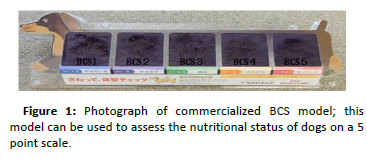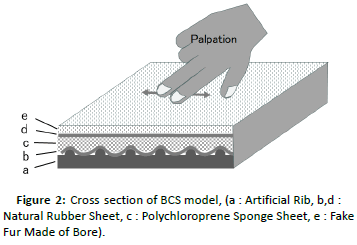Kazuya Otsuji* and Akiko Koizumi
Department of Animal science, Teikyo University of Science, Tokyo, Japan
- Corresponding Author:
- Otsuji K
Department of Animal science, Teikyo University of Science, Tokyo, Japan
E-mail: otsuji-kazuya@ntu.ac.jp
Received date: December 17, 2020; Accepted date: January 1, 2021; Published date: January 8, 2021
Citation: Otsuji K (2021) Body Condition Score Model for Dogs: A New Tool for Nutritional Assessment. J Vet Med Surg Vol.5 No.1:29.
Body condition score model for dogs has been developed to
make more accurate BCS assessment. The BCS model has
been shown to be more useful for communicating with dog
owners than as a supporting tool for BCS assessment.
Description
The indoor breeding rate of dogs and cats is increasing in Japan in recent years and the pets are more exposed to the
temptation of food by living indoors with their owners. In
contrast, owing to the efforts of the pet food company, pet food
is progressively becoming more appetizing and the pets yield to
the temptation of the delicious food. Some owners also feed
excessive food to their pets to satisfy its appetite, possibly
leading to obesity.
Although the data on the obesity rate in dogs is insufficient,
30% or more of present-day dogs are estimated to be obese [1].
Generally, obesity must be assessed by the body fat percentage,
however, its measurement is challenging. Consequently, clinical
veterinarians use the Body Condition Score (BCS) for the
assessment of the nutritional status of dogs and cats. The BCS
method is recommended by the American Animal Hospitals
Association and the World Small Animal Veterinary Association
[2,3]. Since BCS assessment is a sensory evaluation which uses
visual inspection and palpation, the results may differ depending
on the assessor. Therefore, although the veterinarian informs
the assessment results to the pet owners, the latter sometimes
do not accept the assessment results. The treatment of obesity
frequently interferes with this discrepancy. In such a
background, we developed a BCS model for dogs. The model
was prepared by laminating sponge rubber, rubber sheet, and
fake fur on the artificial rib composed of resin, and adjusting the
tactile sensation corresponding to each BCS score (Figures 1 and
2).
Figure 1: Photograph of commercialized BCS model; this
model can be used to assess the nutritional status of dogs on a 5
point scale.
Figure 2: Cross section of BCS model, (a : Artificial Rib, b,d :
Natural Rubber Sheet, c : Polychloroprene Sponge Sheet, e : Fake
Fur Made of Bore).
The veterinary nursing students and clinical veterinarians used
this model to assess BCS for dogs. Consequently, the variation in
the BCS evaluation results became smaller than when it was
evaluated without using the model [4].
Additionally, the veterinarians and dog owners assessed the
BCS of dogs using the model and heard the impression through a
questionnaire survey. The following are the summaries from
both groups [5,6].
Summary of clinical veterinarian answers
Ninety-one percent of the veterinarians answered that the
palpation feeling of the BCS model was identical or wellmatched
to the actual dogs.
Eighty-eight percent of veterinarians answered that the BCS
model was helpful for BCS assessment.
Ninety-five percent of veterinarians answered that the BCS
model was quite helpful for explaining the diagnosis results to
the owners.
Ninety-six percent of veterinarians replied that the BCS model
should be used in animal hospitals owing to its utility as a
communication tool between pet owners.
Eighty-one percent of veterinarians perceived that the BCS
model made it easier for pet owners to recommend weight loss
programs.
Forty-three percent of veterinarians suggested that the
success rate of the weight loss program would increase upon
using the BCS model.
Seventy-nine percent of veterinarians answered that they
would use the BCS model to explain the nutritional status or
provide nutritional education to dog owners. Unexpectedly, few
veterinarians answered that they would use it for staff education
or as an aid in their self BCS assessment.
Summary of the dog owner's answers
• Few dog owners knew about BCS since most veterinarians
assessed the BCS and discussed the results with them.
• Sixty-seven percent of the dog owners thought that they
understood the nutritional status of their dog exceptionally or
moderately well when they tried BCS assessment by using the
model even at the first attempt.
• Dog owners were interested in the BCS model, and assumed it
would be useful for nutritional management.
• Sixty percent of the dog owners were interested in consulting
the clinic staff if their dogs were obese; however, 22% did not
want to consult.
• As a forementioned, the BCS model for dogs is a beneficial
tool in animal hospitals. Its use is already widespread in
Japanese animal hospitals and has been initiated in some other
countries. We anticipate its forthcoming use in many animal
clinics worldwide.
References
- Lund EM, Armstrong PJ, Kirk CA, Klausner JS (2006) Prevalence and risk factors for obesity in adult dogs from private US veterinary practices. Intern J Applied Res VetMed 4: 177-186.
- China JM, Zhaofei X, Jiangnan C, Jinhai Y (2013 ) Prevalence and risk factors for canine obesity surveyed in veterinary practices in Beijing. Prev Vet Med 112: 438-442.
- Baldwin K, Bartges J, Buffington T, Freeman LM, Grabow M, et al. (2010) AAHA nutritional assessment guideline for dogs and cats. J American Animal Hosp Ass. 46: 285-296
- Freman F, Becvarova I, Cave N, Mackey C, Nguyen P, et al. (2011) Nutritional assessment guideline. J Small Ani Pract. 52: 385-396
- Otsuji K, Koizumi A, Kobayashi N, Suzuki M, Furukawa N, et al. (2016) Effectiveness of the body condition score model for the nutritional assessment in dogs. J Pet Ani Nutr. 19: 15-20
- Koizumi A, Aoyama K, Morishita M, Sugiyama Y, Otsuji K (2018) Effectiveness of the body condition score model for nutritional assessment in dogs (the 2dg report): a questionnaire survey of veterinary practisoners and dog owners. J Pet Ani Nutr. 21: 95-101



